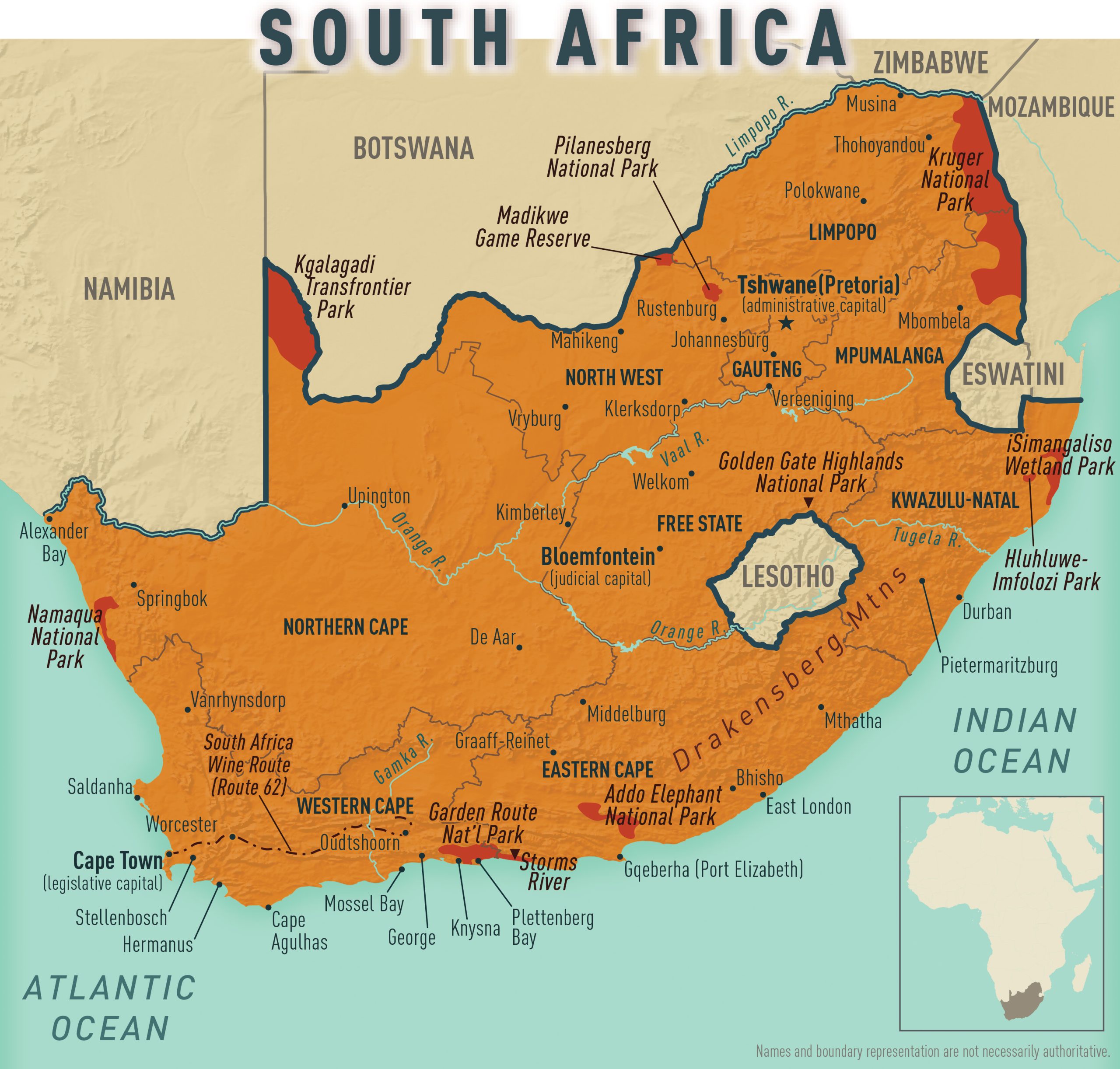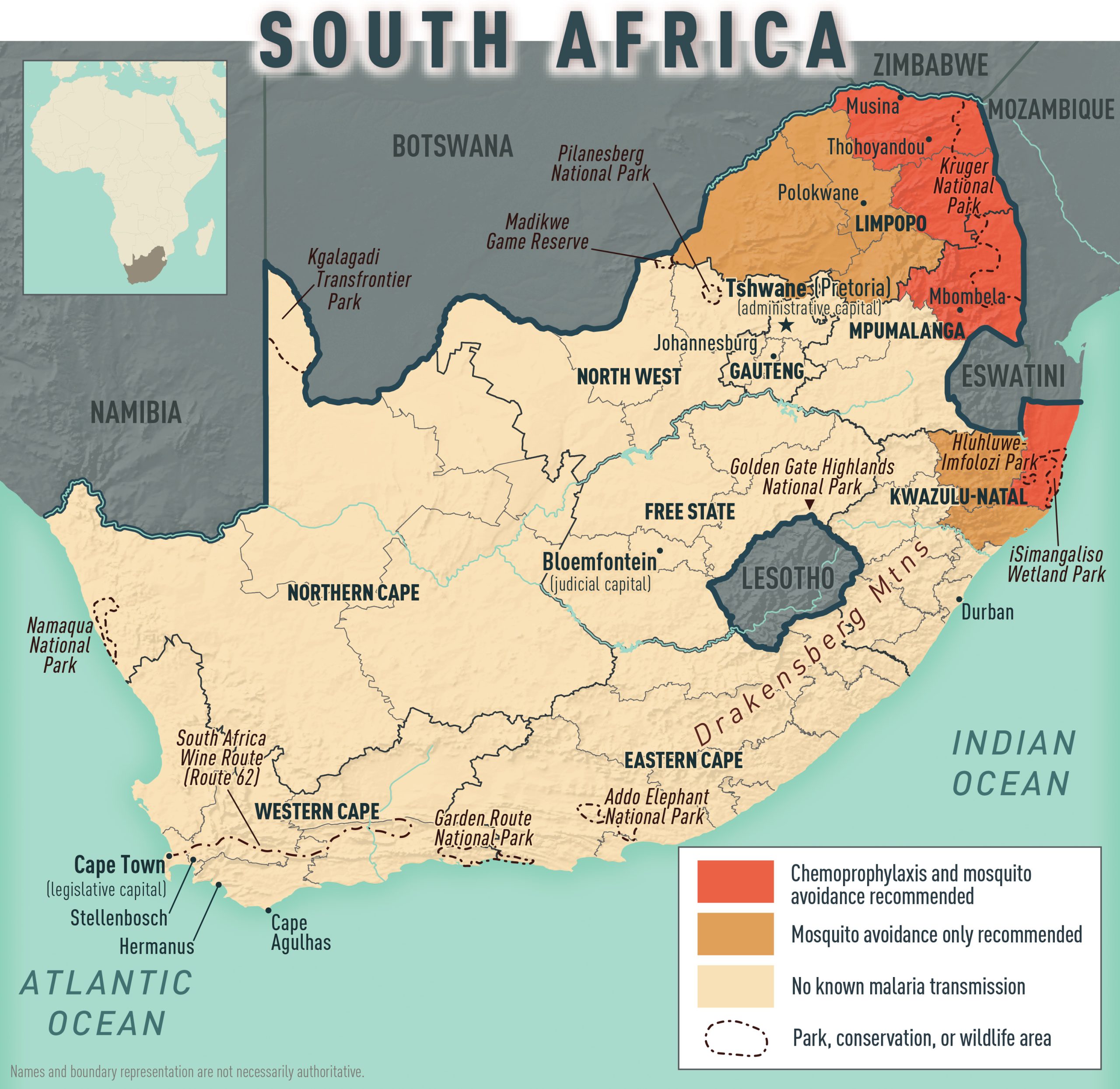Purpose

Destination overview
South Africa is referred to as "a world in one country," due to its diversity in scenery, flora, fauna, and people. Varied geography stretches to all points of the compass, including lush subtropical regions, wetlands, beautiful mountains, vineyards, magnificent arid areas, national parks, and expansive game reserves. The people who live in South Africa, with origins in Africa, Europe, India, and Southeast Asia, bring together a vibrant variety of arts, cuisines, and global culture. All this, combined with modern conveniences of a developed infrastructure, make South Africa a truly unique destination.
South Africa is the only country in the world with 3 capital cities: Cape Town, the seat of Parliament, is the legislative capital; Tshwane (Pretoria) is the administrative and executive capital where the president and the cabinet have their offices and where most foreign embassies are located. Bloemfontein is the judicial capital and houses the Supreme Court of Appeal. Although not a political capital, Johannesburg is the most populous city, the economic hub, and houses the seat of the Constitutional Court of South Africa.
The last 2 decades have seen a substantial increase in tourism and business travel from Europe, North America, and within Africa. Business travelers typically head to the commercial centers of Johannesburg, Cape Town, or Durban. South Africa is also a common destination for humanitarian aid workers, missionaries, and students. A sizable number of South Africans live outside the country; those returning home for a visit are considered visiting friends and relatives (VFR) travelers (see Visiting Friends and Relatives: VFR Travel chapter). Tourist itineraries are as diverse as the country itself, and travelers are able to enjoy a variety of styles of travel, from very upmarket stays to backpacking adventures (Box 11.1.3.1).
Box 11.1.3.1
National parks with game reserves are located throughout the country and attract many tourists (see Map 11.1.3.1); and even more reserves and parks exist beyond those shown on the map. Many small, luxury game reserves (not shown) have emerged to cater to high-end travelers.
Map 11.1.3.1

Centers for Disease Control and Prevention
Infectious disease risks
All travelers to South Africa should be up to date on routine vaccinations, including diphtheria-tetanus-pertussis and measles-mumps-rubella. Travelers going to or transiting through South Africa are advised to seek the most current information by consulting the Centers for Disease Control and Prevention (CDC) Travelers' Health website, the websites of the U.S. Embassy and consulates in South Africa, and the Embassy of South Africa in Washington, DC.
Enteric infections and diseases
Travelers' diarrhea
As with most destinations, the risk for travelers' diarrhea in South Africa depends on style of travel and travelers' food choices (see Travelers' Diarrhea and Food and Water Precaution for Travelers chapters). In the past, tap water was safe to drink in most major cities. However, frequent nationwide rolling electricity blackouts (known locally as "load shedding") in recent years have affected operation of drinking water systems, and water quality is now more variable, so travelers could consider treating tap water or drinking bottled water in cities. In more rural areas, travelers should consume only bottled water. The usual spectrum of bacterial, viral, and parasitic infections exists in South Africa. Educate travelers about the prevention and self-treatment of travelers' diarrhea.
Typhoid fever
Sporadic cases of typhoid are reported in South Africa, but the risk for this disease to travelers is low. Vaccination is recommended for most travelers, especially those staying with friends or relatives or visiting smaller cities or rural areas (see Typhoid and Paratyphoid Fever chapter).
Cholera
In 2023, there were several cholera outbreaks in South Africa outside of metropolitan areas. The initial cases were imported cases, but local transmission was established in several locations with very poor water and sanitation conditions. Cholera vaccination is recommended for travel to areas with active cholera transmission. As most travelers to South Africa do not visit areas with active cholera transmission, they can prevent infection by consistently implementing food and water precautions and hand hygiene without vaccination (see Cholera chapter).
Respiratory infections and diseases
Coronavirus disease 2019
People planning travel to South Africa can review the most current COVID-19 situation information and guidance from the South Africa National Institute for Communicable Diseases. All travelers should be up to date with their COVID-19 vaccines.
Influenza
Influenza viruses typically circulate during winter months in South Africa, which are opposite to the Northern Hemisphere winter months; influenza transmission occurs during May–September. The burden of influenza in South Africa is substantial. Based on a 2013–2015 estimate, 19.8% (approximately 10,737,847) of South Africans develop influenza-associated illness annually; of these, approximately 128,173 are severe cases and 11,536 are deaths. Travelers should have an influenza vaccination with the recommended Southern Hemisphere formulation, if available.
Measles, mumps, pertussis, and diphtheria
In 2022, a pertussis outbreak occurred. In 2023, mumps and measles (see Measles [Rubeola] chapter) outbreaks occurred and a small number of laboratory-confirmed cases of diphtheria were reported from several provinces in South Africa. Travelers should ensure they are up to date for routine vaccinations before travel to South Africa, including the diphtheria-tetanus-pertussis, measles-mumps-rubella (MMR) vaccine, and other routine vaccines. Infants traveling to South Africa should get an early dose of MMR vaccine before travel if aged 6–11 months; this dose does not count as part of the routine childhood vaccination series (see additional information on MMR vaccine and travel).
Tuberculosis
The World Health Organization classifies South Africa as a high-burden country for tuberculosis. Travelers spending time in high-risk settings or in crowded institutions (e.g., working with refugees, in hospitals, medical clinics, prisons) are at risk for exposure. Discuss the importance of testing before and after travel and measures that travelers at risk can take to prevent infection. Travelers with anticipated exposure risks should undergo pre- and post-travel testing (see Tuberculosis chapter).
Sexually transmitted infections and HIV
South Africa has the largest estimated number of people living with HIV worldwide. The prevalence of HIV infection varies by province (10.0%–22.3%) among people aged 15–49 years, and the prevalence among sex workers is considerably higher. Other sexually transmitted infections (STIs) also are present at high rates, including gonorrhea with high-level resistance to ciprofloxacin. Therapy with ceftriaxone is recommended for travelers returning from South Africa who are diagnosed with gonorrhea. Ensure that travelers are aware of the significant HIV and STI risks in South Africa and the importance of using condoms when having sex with someone whose HIV or STI status is unknown. Additionally, counsel travelers who have a greater risk for HIV and other STI acquisition while in South Africa about pre- and post-exposure prophylaxis. Notably since 2022, mpox cases have been reported in South Africa (for more information about HIV and STIs, see the Travelers with HIV and Sex and Travel chapters).
Soil- and waterborne infections
Schistosomiasis
Schistosoma spp. parasites, found throughout Africa, can be present in any body of unchlorinated, freshwater (see Schistosomiasis chapter). Schistosoma haematobium is the dominant species in South Africa, but Schistosoma mansoni occasionally has been detected. Advise travelers to avoid swimming in lakes, streams, and in reservoirs in Limpopo, Mpumalanga, North West, KwaZulu-Natal, the Eastern Cape, and Gauteng provinces. By contrast, the provinces of Western Cape, Northern Cape, and most of Free State are considered schistosomiasis-free.
Vector-borne diseases
African trypanosomiasis
There is no risk for African trypanosomiasis in South Africa, but diagnostics and treatment are available for imported cases.
Malaria
Plasmodium falciparum malaria occurs along the borders with Zimbabwe and Mozambique in the Mopani and Vhembe Districts of Limpopo Province; in the Ehlanzeni District of Mpumalanga Province; and in the uMkhanyakude District of KwaZulu-Natal Province. Kruger National Park spans 2 provinces, Mpumalanga and Limpopo, and is considered endemic for malaria with seasonal transmission (see Map 1.5.39). Visitors to these areas should take malaria chemoprophylaxis and use mosquito-bite precautions; preventing mosquito bites is the first line of defense against malaria (see Mosquitoes, Ticks, and Other Arthropods, and Malaria chapters).
In 2017, after a seasonal malaria outbreak in Limpopo Province, CDC received reports of malaria in the western Waterberg District, an area with historical malaria transmission. Subsequently, only sporadic cases have been reported there (see Yellow Fever Vaccine and Malaria Prevention Information, by Country chapter). Rare cases of imported "Odyssean" malaria (alternatively known as taxi, suitcase, or airport malaria) were likely related to relocation of infected mosquitoes from endemic areas. These cases have been reported mainly in Gauteng province (where Johannesburg and Pretoria are located).
The South African National Department of Health recommends that travelers practice mosquito avoidance year-round in malaria risk areas and take malaria chemoprophylaxis during September–May. CDC, however, recommends chemoprophylaxis at all times of the year. Artemisinin combination therapy remains effective for treatment, and artemether-lumefantrine is the first-line therapy for uncomplicated infection. Intravenous artesunate is widely available for severe malaria treatment.
Map 1.5.39

Centers for Disease Control and Prevention
Rickettsial diseases
African tick bite fever is common in South Africa (see Rickettsial Diseases chapter). The disease is characterized by an acute febrile illness, eschar at the bite site, regional lymphadenopathy, and in some cases a maculopapular or petechial rash. The spectrum of illness varies from mild to, rarely, more severe disease resulting in hemorrhage and multisystem pathology. Campers and hikers in rural areas are especially at risk and should take measures to prevent tick bites (see Mosquitoes, Ticks, and Other Arthropods chapter). Travelers taking doxycycline for malaria chemoprophylaxis might have some protection against tick bite fever, but no studies exist to support or refute this viewpoint. Taking doxycycline solely as prophylaxis for tick bite fever (as opposed to taking it for malaria chemoprophylaxis) is not recommended.
Yellow fever
There is no risk for yellow fever in South Africa.
Yellow fever vaccine requirements
South Africa requires a valid International Certificate of Vaccination or Prophylaxis (ICVP), documenting yellow fever vaccination ≥10 days before arrival in South Africa for all travelers aged ≥1 year, traveling from or transiting for >12 hours through the airport of a country with risk for yellow fever virus transmission. South Africa considers a 1-time dose of yellow fever vaccine (properly documented with an ICVP) to be valid for the life of the traveler. Any traveler not meeting this requirement can be refused entry to South Africa or quarantined for ≤6 days. Unvaccinated travelers presenting a medical waiver signed by a licensed healthcare professional are generally allowed entry.
Viral hemorrhagic fevers
Rare cases of Crimean-Congo hemorrhagic fever have been reported in travelers visiting farms and rural areas of South Africa. It remains an occupational disease in animal health workers, farmers, and hunters. Rift Valley fever occurs in South Africa, and the last major outbreak was in 2010, affecting livestock with spillover to human cases as a result of occupational exposure to tissue and body fluids of infected animals.
Environmental hazards and risks
Animal bites and rabies
Rabies is endemic to South Africa, and dogs are the major source for human rabies cases. The KwaZulu-Natal and Eastern Cape provinces have the highest incidence of rabies. Travelers have no way of telling whether an animal is rabid and should avoid all contact with animals. Instruct travelers to thoroughly wash any bite or scratch from an animal with soap and water immediately and to visit a health facility as soon as possible and inform them of concerns around rabies risk.
Rabies vaccine and rabies immunoglobulin are available for post-exposure prophylaxis in the majority of major centers in both the public and private health sector, but access and availability will vary, and these treatments will likely be less available in rural areas. Consider pre-exposure rabies prophylaxis for travelers spending time in rural areas (see Zoonotic Exposures: Bites, Scratches, and Other Hazards and Rabies chapters). Most of the new formulations of equine rabies immune globulin used in the South African public health system are potent, highly purified, and safe. Some private medical centers stock human rabies immune globulin.
Climate and sun exposure
Latitude and elevation are major factors in the amount of solar ultraviolet radiation (UVR) that reaches the Earth's surface. South Africa's latitude spans 22°S to 34°S, and its elevation ranges from sea level to approximately 3,482 m (11,500 ft), although the average height of Highveld plateau in the interior of the country is around 1,200 m (4,000 ft). In some areas of South Africa (e.g., Durban, Pretoria), the UV index exceeds 11 in the summer months, which is considered very high. Given the frequent cloud-free skies, travelers should wear a broad-brimmed hat, sunglasses, a broad-spectrum sunscreen of ≥30 sun protection factor (SPF) on exposed skin, and sun-protective clothing to lessen the likelihood of sun damage and sunburn (see Sun Exposure in Travelers chapter).
Safety and security
Crime
Over the past several years, South Africa has experienced a rise in violent crime, including armed robberies, car jackings, home invasions, kidnappings, and rape (see Safety and Security Overseas chapter). All travelers should exercise vigilance in personal safety and seek local guidance on appropriate security precautions to take in specific areas.
Unrest
In 2021, in the context of a struggling economy made worse by the COVID-19 pandemic and the arrest of former President Jacob Zuma, South Africa experienced major political unrest. Violent clashes between protesters and police, along with looting, occurred primarily in metropolitan areas, especially Durban and Johannesburg. With a rising cost of living, inequality, and a high unemployment rate, especially among youth, the threat of social unrest has remained, with periodic demonstrations. To stay informed and avoid being accidently caught in areas of potential unrest, travelers should enroll in the U.S. Department of State's Smart Traveler Enrollment Program before traveling and follow the local news while in South Africa.
Rolling blackouts
Due to energy shortages, South Africa has been experiencing worsening scheduled rolling blackouts (known as "load shedding"), which began over 15 years ago. Most hotels and restaurants, particularly in urban areas, have generators.
Traffic-related injuries
South Africa has a modern road system, which frequently leads to travel at high speeds. Drivers should be alert for dangerous driving practices, stray animals, speed bumps, or poor-quality roads in some areas, particularly remote rural areas (see Injury and Death During Travel chapter). During load shedding, extra caution should be used while driving because of outages of traffic lights (known locally as "robots"), which are treated as a 4-way stop. Travelers should plan in advance during scheduled load shedding, when delays and accidents can occur.
Availability of quality medical care
Although South Africa has a wide range of living standards, most visitors experience standards comparable to those in high-income countries in the private sector, accessible to most middle- and upper-income South Africans. Fewer visitors go to rural areas or to the lower-income townships, found on the outskirts of towns and cities, which are commonly served by under-resourced public-sector facilities.
Medical tourism
Because of the affordable and high-quality private health sector in South Africa, medical tourism is steadily on the rise. Travelers to South Africa for medical tourism frequently access cancer treatment, cosmetic surgery, dental, fertility, or transplant services (see Medical Tourism chapter).
- De Boni, L., Msimang, V., De Voux, A., & Frean, J. (2021). Trends in the prevalence of microscopically-confirmed schistosomiasis in the South African public health sector, 2011–2018. PLoS Neglected Tropical Diseases, 15(9), e0009669. https://www.doi.org/10.1371/journal.pntd.0009669
- Frean, J., & Grayson, W. (2019). South African tick bite fever: An overview. Dermatopathology (Basel, Switzerland), 6(2), 70–76. https://www.doi.org/10.1159/000495475
- Johnson, L. F., Meyer-Rath, G., Dorrington, R. E., Puren, A., Seathlodi, T., Zuma, K., & Feizzadeh, A. (2022). The Effect of HIV Programs in South Africa on National HIV Incidence Trends, 2000-2019. Journal of acquired immune deficiency syndromes (1999), 90(2), 115–123. https://doi.org/10.1097/QAI.0000000000002927
- Kakooza, F., Golparian, D., Matoga, M., Maseko, V., Lamorde, M., Krysiak, R., . . . Unemo, M. (2023). Genomic surveillance and antimicrobial resistance determinants in Neisseria gonorrhoeae isolates from Uganda, Malawi and South Africa, 2015–20. The Journal of Antimicrobial Chemotherapy, 78(8), 1982–1991. https://www.doi.org/10.1093/jac/dkad193
- Moodley, I., Kleinschmidt, I., Sharp, B., Craig, M., & Appleton, C. (2003). Temperature-suitability maps for schistosomiasis in South Africa. Annals of Tropical Medicine and Parasitology, 97(6), 617–627. https://www.doi.org/10.1179/000349803225001445
- National Department of Health. (2020). National guidelines for the treatment of malaria, South Africa 2019. Pretoria: The Department. Health.gov.za. https://www.health.gov.za/wp-content/uploads/2020/11/national-guidelines-for-the-treatment-of-malaria-south-africa-2019.pdf
- National Institute for Communicable Disease. National Institute for Communicable Disease, Division of the National Health Laboratory Service. https://www.nicd.ac.za
- Tempia, S., Walaza, S., Moyes, J., Cohen, A. L., McMorrow, M. L., Treurnicht, F. K., . . . Cohen, C. (2019). Quantifying how different clinical presentations, levels of severity, and healthcare attendance shape the burden of influenza-associated illness: A modeling study from South Africa. Clinical Infectious Diseases, 69(6), 1036–1048. https://www.doi.org/10.1093/cid/ciy1017
- Weyer, J., Dermaux-Msimang, V., Grobbelaar, A., Le Roux, C., Moolla, N., Paweska, J., & Blumberg, L. (2020). Epidemiology of human rabies in South Africa, 2008–2018. South African Medical Journal, 110(9), 877–881. https://www.researchgate.net/publication/344051711_Epidemiology_of_human_rabies_in_South_Africa_2008_-_2018
